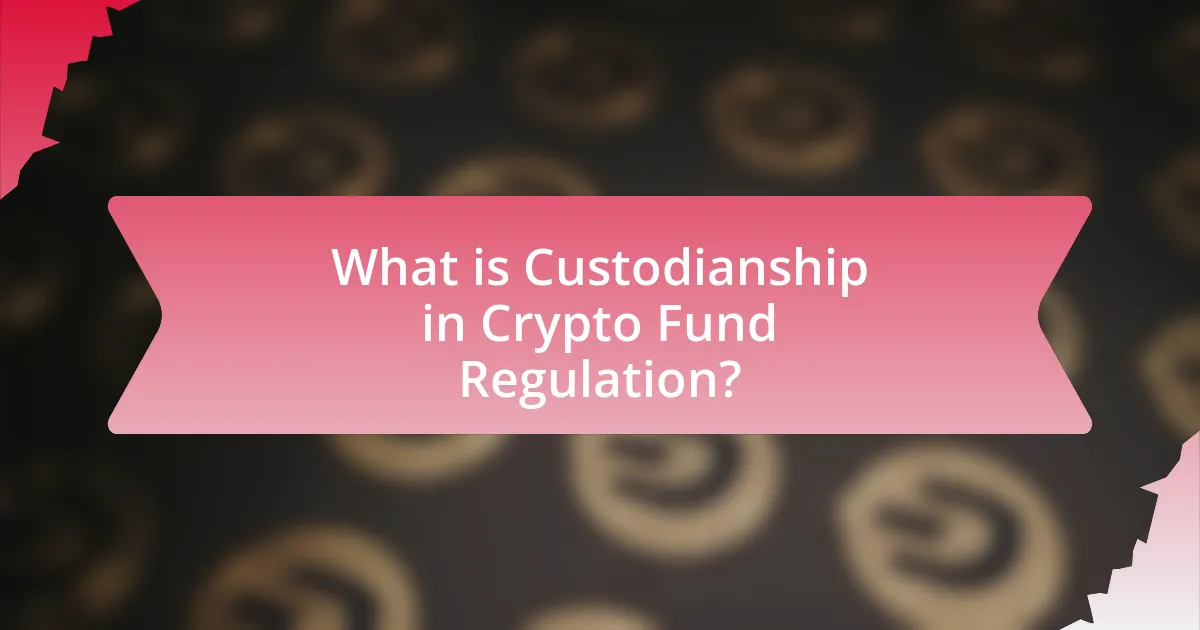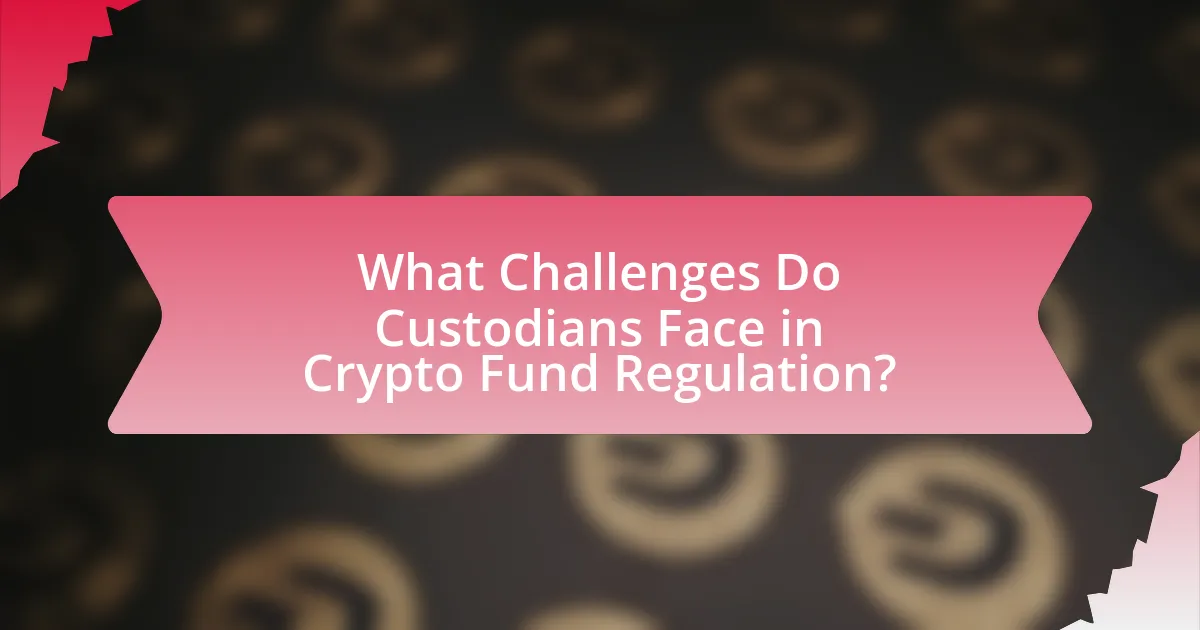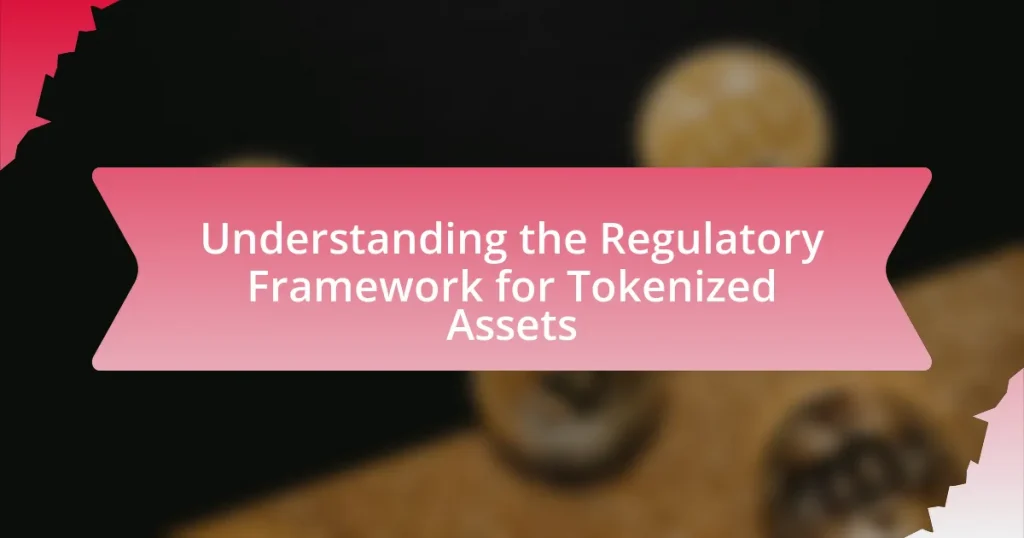Custodianship in crypto fund regulation is the responsibility of custodians to safeguard and manage digital assets for investors, ensuring security, integrity, and accessibility. This article outlines the critical role custodians play in mitigating risks associated with cryptocurrency investments, such as theft and fraud, through stringent security measures and regulatory compliance. It discusses the regulatory requirements custodians must adhere to, the impact of custodianship on investor confidence, and the emerging trends and challenges within the crypto landscape. Additionally, the article highlights best practices for selecting a custodian and the importance of technological advancements in enhancing custodial services.

What is Custodianship in Crypto Fund Regulation?
Custodianship in crypto fund regulation refers to the responsibility of a custodian to safeguard and manage digital assets on behalf of investors. This role is crucial as it ensures the security, integrity, and accessibility of cryptocurrencies held within a fund. Custodians are typically regulated financial institutions that implement stringent security measures, such as multi-signature wallets and cold storage, to protect assets from theft or loss. The necessity for custodianship arises from the inherent risks associated with cryptocurrency investments, including hacking and fraud, which have led to significant financial losses in the past. Regulatory bodies, such as the SEC in the United States, emphasize the importance of custodianship to enhance investor protection and maintain market integrity.
Why is custodianship crucial in the context of crypto funds?
Custodianship is crucial in the context of crypto funds because it ensures the secure storage and management of digital assets, mitigating risks such as theft and loss. The volatile nature of cryptocurrencies and their susceptibility to cyberattacks necessitate a reliable custodial service to protect investors’ assets. According to a report by the Financial Stability Board, effective custodianship can enhance investor confidence and promote market integrity, as it provides a safeguard against fraud and mismanagement. Furthermore, regulatory frameworks increasingly require custodianship to comply with legal standards, ensuring that crypto funds operate within a secure and transparent environment.
What role do custodians play in safeguarding digital assets?
Custodians play a critical role in safeguarding digital assets by providing secure storage solutions and ensuring compliance with regulatory standards. They utilize advanced security measures, such as multi-signature wallets and cold storage, to protect assets from theft and hacking. Additionally, custodians often implement robust auditing processes and insurance policies to further enhance the security and integrity of the digital assets they manage. This is essential in the context of crypto fund regulation, as it helps build trust among investors and ensures adherence to legal requirements.
How does custodianship mitigate risks associated with crypto investments?
Custodianship mitigates risks associated with crypto investments by providing secure storage and management of digital assets. This secure storage reduces the likelihood of theft or loss due to hacking, as custodians implement advanced security measures such as multi-signature wallets and cold storage solutions. Additionally, custodians often offer insurance coverage for assets held, further protecting investors from potential financial losses. According to a report by the Financial Stability Board, regulated custodians can enhance investor confidence and market integrity by adhering to strict compliance and regulatory standards, which helps to minimize fraud and operational risks in the crypto space.
What are the regulatory requirements for custodians in the crypto space?
Custodians in the crypto space must comply with various regulatory requirements, including registration with financial authorities, adherence to anti-money laundering (AML) and know your customer (KYC) regulations, and implementation of robust cybersecurity measures. For instance, in the United States, custodians are often required to register as money services businesses (MSBs) with the Financial Crimes Enforcement Network (FinCEN) and comply with state-level regulations. Additionally, the European Union’s Markets in Crypto-Assets (MiCA) regulation mandates that custodians maintain adequate capital reserves and implement risk management frameworks. These requirements are designed to enhance investor protection and ensure the integrity of the financial system in the rapidly evolving crypto landscape.
Which regulatory bodies oversee custodianship in crypto fund management?
The regulatory bodies that oversee custodianship in crypto fund management include the Securities and Exchange Commission (SEC) in the United States, the Financial Conduct Authority (FCA) in the United Kingdom, and the European Securities and Markets Authority (ESMA) in the European Union. These organizations establish guidelines and regulations to ensure the security and integrity of digital assets held by custodians. For instance, the SEC requires registered investment companies to comply with specific custody rules under the Investment Company Act of 1940, which mandates that funds must maintain their assets with a qualified custodian.
What compliance standards must custodians adhere to?
Custodians must adhere to compliance standards such as the Financial Industry Regulatory Authority (FINRA) regulations, the Securities and Exchange Commission (SEC) guidelines, and the Anti-Money Laundering (AML) laws. These standards ensure that custodians maintain the integrity and security of client assets, comply with reporting requirements, and implement measures to prevent illicit activities. For instance, FINRA requires custodians to follow strict guidelines for safeguarding customer funds, while the SEC mandates transparency in asset management practices. Compliance with these standards is crucial for custodians to operate legally and maintain trust in the financial system.

How does Custodianship Impact Investor Confidence?
Custodianship significantly enhances investor confidence by ensuring the security and integrity of assets. When investors know that their digital assets are held by reputable custodians, it reduces the perceived risk of theft, fraud, or mismanagement. For instance, a study by the Cambridge Centre for Alternative Finance found that 70% of institutional investors cited security as a primary concern when investing in cryptocurrencies. This highlights that effective custodianship, which includes robust security measures and regulatory compliance, directly correlates with increased trust among investors. Furthermore, custodians often provide transparency through regular audits and reporting, further solidifying investor confidence in the management of their assets.
What benefits does effective custodianship provide to investors?
Effective custodianship provides investors with enhanced security for their assets, ensuring that their digital currencies are protected against theft and fraud. Custodians implement advanced security measures, such as multi-signature wallets and cold storage solutions, which significantly reduce the risk of unauthorized access. Additionally, effective custodianship offers regulatory compliance, which instills confidence in investors by ensuring that the custodial services adhere to legal standards and best practices. This compliance can lead to greater market stability and investor protection, as evidenced by the increasing number of regulatory frameworks being established globally for cryptocurrency custodians.
How does custodianship enhance the security of investor assets?
Custodianship enhances the security of investor assets by providing specialized services that protect and manage those assets. Custodians implement robust security measures, including advanced encryption, multi-factor authentication, and regular audits, to safeguard digital assets from theft and loss. For instance, a report by the Financial Stability Board highlights that custodians are essential in mitigating risks associated with asset management, as they ensure compliance with regulatory standards and provide insurance coverage for assets held in custody. This combination of technological safeguards and regulatory compliance significantly reduces the likelihood of asset misappropriation, thereby enhancing overall investor confidence and security.
In what ways does custodianship influence investor decision-making?
Custodianship significantly influences investor decision-making by providing security, transparency, and regulatory compliance. Investors are more likely to engage with funds that utilize custodianship because it mitigates risks associated with asset theft and mismanagement. For instance, a study by PwC in 2020 indicated that 82% of institutional investors consider custodianship essential for their investment decisions in cryptocurrency, highlighting its role in fostering trust. Furthermore, custodianship ensures that assets are held in compliance with regulations, which reassures investors about the legitimacy and safety of their investments. This regulatory alignment can lead to increased capital inflow into crypto funds, as investors feel more secure knowing their assets are managed by reputable custodians.
How does custodianship affect the overall market for crypto funds?
Custodianship significantly enhances the overall market for crypto funds by providing security and regulatory compliance, which fosters investor confidence. When custodians manage the assets of crypto funds, they implement robust security measures, such as cold storage and multi-signature wallets, reducing the risk of theft or loss. According to a report by PwC, 77% of institutional investors indicated that the presence of a regulated custodian would increase their willingness to invest in cryptocurrencies. This increased confidence leads to greater participation from institutional investors, which in turn drives market growth and liquidity. Furthermore, custodianship ensures adherence to regulatory standards, which is crucial for the legitimacy and stability of the crypto market, as evidenced by the increasing number of jurisdictions implementing regulations that require custodial services for crypto assets.
What trends are emerging in custodianship practices within the crypto industry?
Emerging trends in custodianship practices within the crypto industry include the adoption of multi-signature wallets, increased regulatory compliance, and the integration of insurance products for digital assets. Multi-signature wallets enhance security by requiring multiple private keys for transactions, thereby reducing the risk of theft. Regulatory compliance is becoming crucial as jurisdictions worldwide implement stricter guidelines for crypto custodians, ensuring that they adhere to anti-money laundering (AML) and know your customer (KYC) regulations. Additionally, the integration of insurance products is gaining traction, with custodians offering coverage against potential losses from hacks or operational failures, which is essential for building trust among institutional investors. These trends reflect a shift towards more secure, compliant, and trustworthy custodianship in the evolving crypto landscape.
How do custodianship services contribute to market stability?
Custodianship services contribute to market stability by safeguarding assets and ensuring compliance with regulatory standards. These services mitigate risks associated with asset management, such as fraud and mismanagement, by providing secure storage and oversight of digital assets. For instance, custodians implement robust security measures, including multi-signature wallets and cold storage, which protect against hacking and theft. Additionally, custodianship services enhance transparency and trust in the market by conducting regular audits and reporting, which helps to maintain investor confidence. This confidence is crucial for market stability, as it encourages participation and investment, ultimately leading to a more resilient financial ecosystem.

What Challenges Do Custodians Face in Crypto Fund Regulation?
Custodians face significant challenges in crypto fund regulation primarily due to the evolving regulatory landscape and the inherent complexities of digital assets. The lack of standardized regulations across jurisdictions complicates compliance efforts, as custodians must navigate varying legal frameworks and requirements. Additionally, the rapid pace of technological advancements in the crypto space often outstrips regulatory responses, leading to uncertainty and potential legal risks for custodians. For instance, the Financial Action Task Force (FATF) has issued guidelines on virtual assets, but implementation varies widely, creating challenges for custodians in ensuring adherence to anti-money laundering (AML) and know-your-customer (KYC) regulations. Furthermore, custodians must also address security concerns related to the safeguarding of digital assets, as breaches can lead to significant financial losses and regulatory repercussions.
What are the common risks associated with custodianship in crypto?
Common risks associated with custodianship in crypto include security vulnerabilities, regulatory compliance issues, and operational risks. Security vulnerabilities arise from potential hacking incidents, as custodial services manage large amounts of digital assets, making them attractive targets for cybercriminals. For instance, in 2021, the Poly Network hack resulted in the theft of over $600 million in cryptocurrencies, highlighting the risks custodians face. Regulatory compliance issues stem from the evolving legal landscape surrounding cryptocurrencies, which can lead to custodians facing penalties or operational disruptions if they fail to adhere to regulations. Additionally, operational risks involve the potential for human error, system failures, or mismanagement, which can result in asset loss or misallocation. These risks underscore the importance of robust security measures, compliance protocols, and effective operational practices in the custodianship of crypto assets.
How do technological advancements impact custodianship practices?
Technological advancements significantly enhance custodianship practices by improving security, efficiency, and transparency in asset management. For instance, the implementation of blockchain technology allows for real-time tracking of assets, reducing the risk of fraud and ensuring that transactions are immutable and verifiable. Additionally, advancements in encryption and cybersecurity measures protect sensitive data from unauthorized access, thereby increasing trust among investors. According to a report by Deloitte, 80% of financial institutions believe that blockchain will revolutionize the way they manage assets, highlighting the transformative impact of technology on custodianship in the crypto fund sector.
What legal challenges do custodians encounter in the crypto space?
Custodians in the crypto space face several legal challenges, primarily related to regulatory compliance, asset security, and liability issues. Regulatory compliance is a significant challenge as custodians must navigate a complex landscape of laws that vary by jurisdiction, including anti-money laundering (AML) and know your customer (KYC) regulations. For instance, in the United States, custodians must comply with the Securities and Exchange Commission (SEC) regulations, which can be ambiguous regarding digital assets.
Asset security poses another challenge, as custodians are responsible for safeguarding clients’ digital assets against theft and hacking, which raises questions about liability in the event of a breach. Additionally, custodians must address the legal implications of operating in a rapidly evolving market where the classification of cryptocurrencies can change, impacting their legal status and the custodians’ obligations.
These challenges are compounded by the lack of standardized regulations across different jurisdictions, making it difficult for custodians to implement uniform compliance measures.
How can custodians improve their services to meet regulatory demands?
Custodians can improve their services to meet regulatory demands by implementing advanced compliance technologies and enhancing transparency in their operations. By adopting automated compliance solutions, custodians can streamline the monitoring of transactions and ensure adherence to regulations such as Anti-Money Laundering (AML) and Know Your Customer (KYC) requirements. For instance, a report by Deloitte highlights that 80% of financial institutions are investing in compliance technology to better manage regulatory risks. Additionally, custodians can enhance transparency by providing real-time reporting and audit trails, which are essential for regulatory scrutiny. This proactive approach not only helps custodians align with regulatory expectations but also builds trust with clients and stakeholders.
What best practices should custodians adopt for compliance?
Custodians should adopt best practices such as implementing robust security measures, conducting regular audits, and ensuring compliance with regulatory frameworks. These practices help safeguard assets and maintain transparency in operations. For instance, employing multi-signature wallets and cold storage solutions significantly reduces the risk of theft or loss, as evidenced by the increasing number of custodians utilizing these technologies to enhance security. Additionally, regular audits by third-party firms ensure adherence to compliance standards, which is crucial given that regulatory bodies like the SEC and FINRA have stringent requirements for custodians in the crypto space. By following these best practices, custodians can effectively mitigate risks and uphold their responsibilities in crypto fund regulation.
How can custodians leverage technology to enhance security and efficiency?
Custodians can leverage technology to enhance security and efficiency by implementing advanced encryption methods, blockchain technology, and automated compliance systems. Advanced encryption ensures that sensitive data is protected from unauthorized access, while blockchain technology provides a transparent and immutable record of transactions, reducing the risk of fraud. Automated compliance systems streamline regulatory reporting and monitoring, allowing custodians to efficiently manage compliance with evolving regulations. For instance, a report by Deloitte highlights that blockchain can reduce operational costs by up to 30% in financial services, demonstrating the tangible benefits of these technologies in enhancing both security and efficiency for custodians.
What are the best practices for selecting a crypto custodian?
The best practices for selecting a crypto custodian include evaluating security measures, assessing regulatory compliance, and reviewing the custodian’s track record. Security measures should encompass multi-signature wallets, cold storage solutions, and insurance coverage against theft or loss, as these features significantly reduce the risk of asset compromise. Regulatory compliance is crucial; custodians must adhere to relevant laws and regulations, such as those set by the Financial Action Task Force (FATF) and local authorities, ensuring they operate within legal frameworks. Additionally, reviewing a custodian’s track record involves examining their history of service, client testimonials, and any past incidents of security breaches, which can provide insights into their reliability and trustworthiness.
What criteria should investors consider when choosing a custodian?
Investors should consider the custodian’s regulatory compliance, security measures, and reputation when choosing a custodian. Regulatory compliance ensures that the custodian adheres to legal standards, which is crucial in the highly regulated crypto environment. Security measures, such as cold storage and multi-signature wallets, protect assets from theft and hacking. A custodian’s reputation, supported by industry reviews and client testimonials, indicates reliability and trustworthiness. For instance, custodians like Coinbase Custody and BitGo are recognized for their robust security protocols and regulatory adherence, making them preferred choices among investors.
How can investors assess the reliability of a custodian’s services?
Investors can assess the reliability of a custodian’s services by evaluating their regulatory compliance, security measures, and track record. Regulatory compliance is crucial; custodians should be registered with relevant authorities and adhere to industry standards, such as those set by the Financial Industry Regulatory Authority (FINRA) or the Securities and Exchange Commission (SEC). Security measures, including insurance coverage for assets and robust cybersecurity protocols, are essential indicators of a custodian’s reliability. Additionally, reviewing the custodian’s track record, including client testimonials and historical performance, provides insight into their operational integrity and reliability. For instance, custodians with a long-standing reputation and positive reviews from institutional investors are generally considered more trustworthy.















